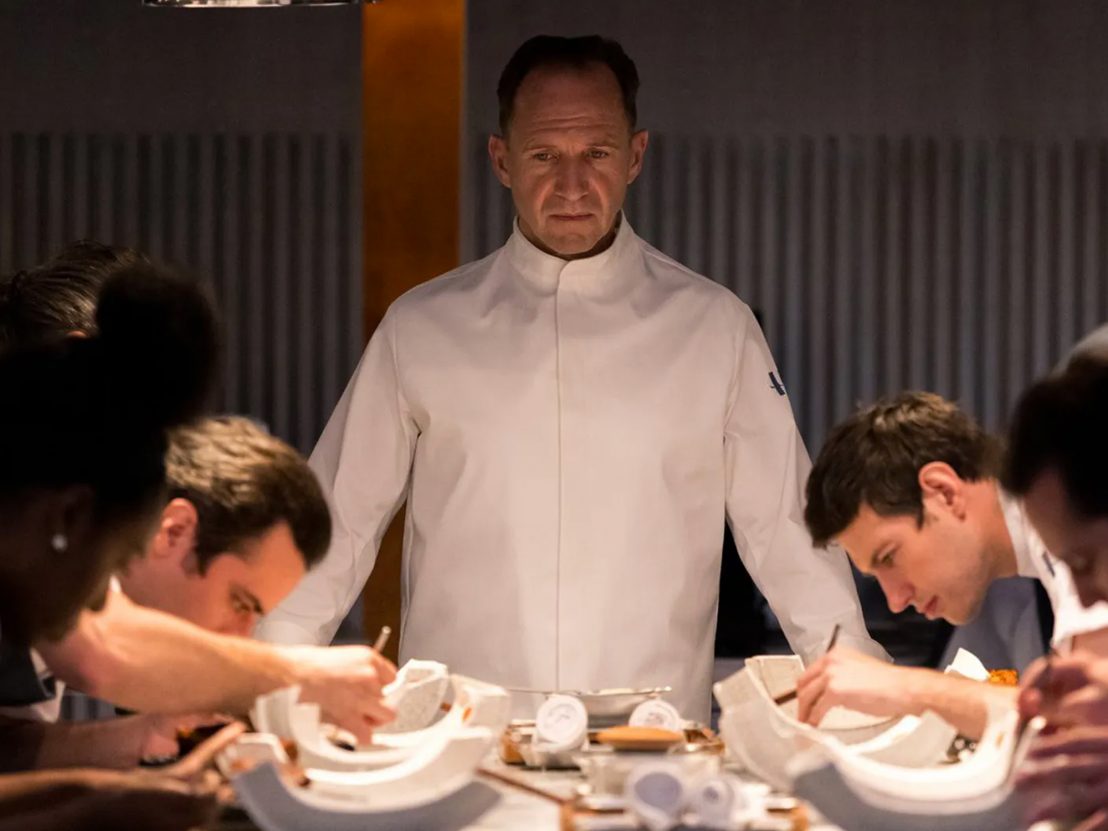
The Menu and Flux Gourmet take food, and the privileged few who can easily afford it, and make them into modern monsters. The same is seen in a glut of other horrors released in the last six months, from indie eating disorder drama Shapeless, to the Welsh language production The Feast, and British supernatural story A Banquet. Food-based horror films have emerged from the waves of crises that have been hitting us since 2020, in every corner of the genre.
Horror films have always acted as mirrors of society, from The Cabinet of Dr. Caligari reflecting the malicious unease of the interwar years to Get Out exposing racism amongst middle-class Obama voters. In this era of austerity, food banks and the “eat or heat” choice that many of us are being forced to make, it is understandable that food has become a major focus for UK and US horror filmmakers.
Both directed by British filmmakers, Mark Mylod’s prestige thriller The Menu and Peter Strickland’s experimental indie Flux Gourmet were created during a time of chaos in the UK. As well as the aftereffects of the pandemic, the UK has been hit by Brexit and chronically underfunded public services finally hitting breaking point, all presided over by successive inept governments.
With a reported budget of $30 million, Mylod’s work is studded with stars, including Anya Taylor-Joy, Ralph Fiennes (who plays the restaurant’s renowned creator Chef Slowik) and Nicholas Hoult. Although the film begins with the patrons willingly travelling to the elite restaurant on a remote island, the situation quickly devolves until they are imprisoned at Hawthorne.
Meanwhile Flux Gourmet does a lot with a fraction of The Menu’s budget. Its small cast includes Asa Butterfield, Gwendoline Christie and Strickland’s regular collaborator Fatma Mohamed, though similarly to The Menu, the majority of the film takes place in one setting: the prestigious Sonic Catering Institute. The film was shot over just 14 days, and this works very well; the film focuses on a culinary collective’s residency, and you can feel the actors building similar relationships to those their characters would have developed during this.
Despite very different tonal choices, Flux Gourmet and The Menu have a lot in common. They both explore food as an artistic performance, enjoyed by wealthy patrons, and satirise the absurdity of people who have enough money to eat tiny portions by choice. Then there are the speeches – both films have characters waxing lyrical about food and their lives, often played for dark comedy. None of these speeches are about a complete lack of food, and the ‘performers’ in each film have not experienced starvation for themselves. Instead many of the speeches discuss the characters willingly wasting food. Several of the speeches become psychosexual, with sex seen as being more important than eating.
In The Menu the privilege of the characters is referred to directly multiple times. After a speech about class and flour, and how the history of breadmaking is one of human survival, Chef Slowik serves a dish composed solely of condiments, saying “You are not the common man, so tonight you get no bread”. A group of tech bros’ response to this is to demand the bread. As their firm is an angel investor in Hawthorne, they believe that they own the restaurant, alongside it’s staff, and should get special treatment. They don’t.
Margot (Anya Taylor-Joy) functions as a counterpoint to the other customers. As soon as she steps onto the island she is marked out as “wrong” by staff. Margot assumes this is because of her working-class status, asking Slowik “You want the address of my mum’s trailer park?” At another point, she is led to the kitchen of the restaurant, and told “You belong here with your own breed”.
Flux Gourmet is much less direct. Strickland prefers the discomfort of surrealism to outright statements, and the resulting film is darkly hilarious. We are laughing at the awkwardness of privately educated liars, who dress exclusively in expensive designer pieces, creating aimless, empty art by sticking wires into cakes. Elle di Elle’s (Fatma Mohamed) troupe have been awarded a valuable sponsorship by the Sonic Catering Institute, but don’t want to take any of the institute’s advice on board. Whilst Slowik openly declares “I am a monster” in The Menu, Strickland uses subtle, but building, characterisation to make us come to the same conclusion about the artists in Flux Gourmet.
However, like Margot in The Menu, Flux Gourmet uses the technique of having a counterpoint character to highlight the privilege of the others. This character is Stones, a journalist brought in to document the residency. His lack of confidence and greed, as well as his gastrointestinal issues, mark him apart from everyone else at the Sonic Catering Institute.
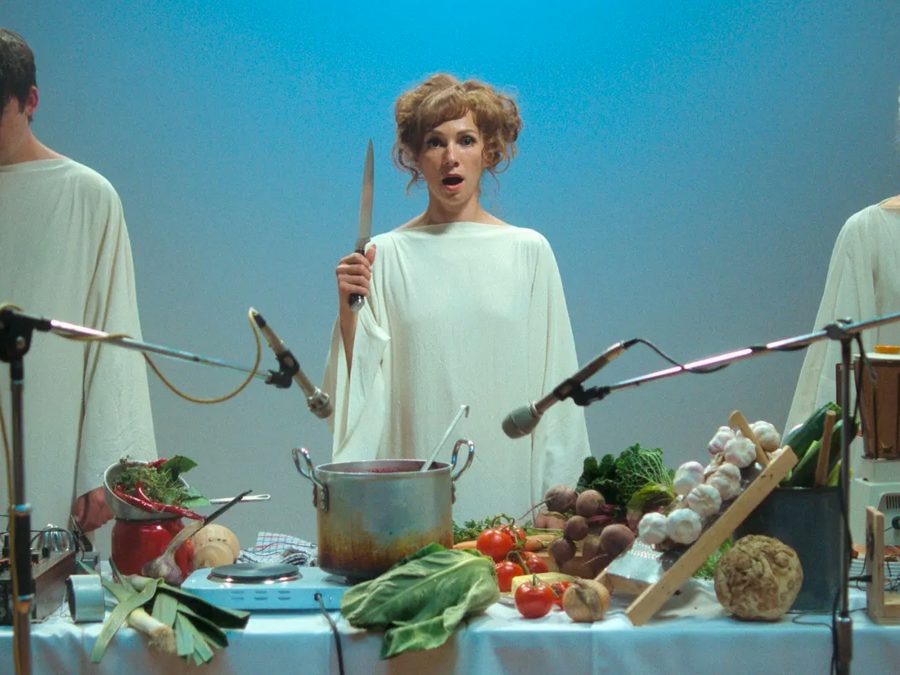
The monstrosity of the wealthy characters in both films is matched by the horrifying nature of the food itself. They explore how an abundance of food, and the wasting of ingredients, is not only insensitive but actively disgusting in these times. This is shown in Flux Gourmet when the noises of the squelching, sucking and slapping of food become so exaggerated it makes food seem deeply unappealing – and that’s before you get to the section where a real endoscopy is “performed” on stage.
In The Menu, the food is gorgeous, but no one enjoys it. The wealthy couple who have visited the restaurant 11 times can’t name a single dish they have consumed there. None of the characters are there to eat food. As in Flux Gourmet, food is not seen as something to enjoy and savour, or even something to be consumed. The guests are there to photograph it, analyse it, or use it as a status symbol. This food is monstrous because it takes something vital to life, something so many people are desperate for, and makes it into something useless. It isn’t until Margot refuses this monster, and instead demands a cheeseburger for $9.95, that food is shown as something worth eating.
The endings of both films reinforce this notion of food as the monster, alongside the wealthy people that waste it. They each conclude with a performance piece that references cannibalism, in which. The wealthy characters who we have come to hate, become the food. This unites the two monstrous elements: the repulsive people become repulsive food, whether in the form of a s’more or being fed into a blender.
These violent closures feel like acts of revenge. As Margot watches Hawthorne explode, she eats her burger, and wipes her mouth with the fancy menu sought out by the rich patrons. In this moment it appears that Mylod is allowing the audience to live vicariously through Margot. Like her, many audience members will be struggling to find money to eat, and watching the wealthy literally burn offers a moment of catharsis.
Meanwhile in Flux Gourmet it is Elle di Elle who is ostensibly made into food. Throughout the film she is controlling and abusive to everyone around her. Although the final moments reveal that she isn’t actually in the blender, up until that point it is satisfying to see such a morally ugly character be consumed by her own artform. By closing their films like this, it seems that Mylod and Strickland are both allowing the audience to have a moment of wish-fulfillment, letting us identify with what is happening on the screen enough to momentarily defeat a monster that is very real in our daily lives: the need for food under austerity.
However, The Menu is a large-scale, Disney-distributed film, and its director is a successful filmmaker. Although it has Margot as a representative of working-class realities, its production and authorship undercut some of its messaging around food poverty. Flux Gourmet’s budget may be modest in comparison, but its arthouse aesthetic is primarily aimed at middle-class audiences, who unfairly have more opportunities to access this kind of work.
As a result these two films have a duality to them. Their use of luxury food as something that is to be looked at rather than consumed results in them critiquing a specific set of people, yet they are targeting their own films at a main audience from that same group. Neither film sets out to be a direct commentary on food poverty, yet by looking at privilege through the lens of food, they both carry the baggage of our current situation. Each film was made in the midst of skyrocketing food-bank use in the UK, and neither of the two British filmmakers will have been unaware of that reality when making their films. Perhaps the next few years will see someone tackle the subject of food poverty head-on in horror – for now, we have to make do with the fantasy of biting the hand that won’t feed.
Published 7 Jan 2023
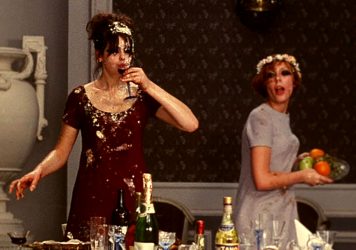
This messy, invariably entertaining cinematic staple can represent anarchy, revenge and sexual release.
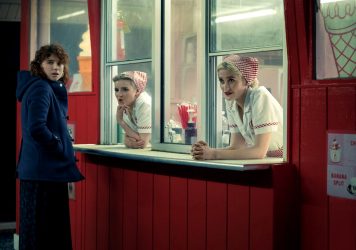
I’m Thinking of Ending Things is another sly critique of capitalism and the commodification of cinema.
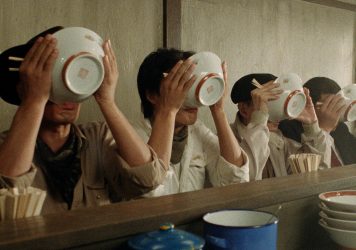
By Anton Bitel
Juzo Itami’s ‘ramen western’ Tampopo – finally out on Blu-ray – is a culinary romp like no other.